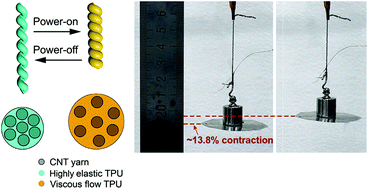Hierarchical carbon nanotube composite yarn muscles†
Abstract
Hybrid smart actuators fabricated using composites of carbon fibers and shape memory polymers have been extensively studied in recent years. However, relatively slow shape recovery has combined with the reset of shape deformation during cycles to restrict their practical use. An electrothermally reversible actuator based on carbon nanotube (CNT) composite yarn containing CNT fiber and thermoplastic polyurethane (TPU) resin with excellent shape memory was investigated in this paper. The combination of CNT yarn and TPU resin considerably amplified the contraction and stability. Large tensile stroke was obtained within 5 s (∼13.8%) while lifting a load that was ∼1905 times as heavy as the actuator. The generated contractive stress reached more than 33 MPa (corresponding to 120 g of the load) at a weight-to-yarn mass ratio of 28 400, which was about 30 times more than the shape recovery stress of shape memory polymer. In terms of the stability study, the process of annealing and contraction training was introduced. In addition, the quantitative relationship between temperature and contraction was also rigorously explored, which facilitated a more accurate and controllable contractile stroke. Great potential applications ranging from soft robots, wearable intelligent devices, and biomimetic devices to self-deployable structures in the aerospace field are likely to benefit from the advantages of low density, fast response without hysteresis, super flexible structure, as well as stitchability and large-scale production.



 Please wait while we load your content...
Please wait while we load your content...